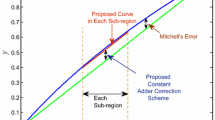Abstract
Autonomous cars, cloud computing and image recognition technology have spread drastically in recent years. However, operation of these applications requires a large number of multipliers and has a high hardware cost. Logarithmic converters can replace the multipliers at the expense of a large conversion error. This paper proposes a design for area-delay-product (ADP)-efficient logarithmic converters that use compensation methods involving mantissa bits. Replacing the conventional constant adder, bit-level manipulation and shift-and-add scheme, the proposed ADP-efficient logarithmic converters use mantissa bits to compensate for the conversion error of the accurate logarithmic curve. According to different specifications and applications of tolerable logarithmic conversion error, three sets of logarithmic converters, that is, methods 1, 2 and 3, were proposed to approximate the accurate logarithmic curve. The proposed ADP-efficient logarithmic converters can achieve a smaller implementation area, shorter latency and lower error than other methods in the literature. The total conversion errors of the proposed ADP-efficient logarithmic converters are 0.0379, 0.0303 and 0.0241 for methods 1, 2 and 3, respectively. Simultaneously, the proposed ADP-efficient logarithmic converters can attain ADP savings of 35.32, 69.71 and 66.19% compared to previous papers, for the proposed methods 1, 2 and 3. The design’s very-large-scale-integration (VLSI) hardware implementation is synthesized by the Taiwan Semiconductor Manufacture Company using 0.18 μm CMOS technology. Additionally, the proposed ADP-efficient implementation structure is ROM-free, fast, simple and has a lower logarithmic conversion error range. The proposed converters can be easily implemented by VLSI digital circuits and may be applied to 5G technology and digital signal processing.










Similar content being viewed by others
References
K.H. Abed, R.E. Siferd, CMOS VLSI implementation of a low-power logarithmic converter. IEEE Trans. Comp. 52(11), 1421–1433 (2003)
D. De Caro, M. Genovese, E. Napoli, N. Petra, A.G. Strollo, Accurate fixed-point logarithmic converter. IEEE Trans. Circuits and Syst. II: Express Briefs 61(7), 526–530 (2014)
D. De Caro, N. Petra, A.G. Strollo, Efficient logarithmic converters for digital signal processing applications. IEEE Trans. Circuits and Syst. II: Express Briefs 58(10), 667–671 (2011)
M. Chaudhary, P. Lee, Two-stage logarithmic converter with reduced memory requirements. IET Comp. and Digital Techn. 8(1), 23–29 (2014)
M. Chaudhary, P. Lee, An improved two-step binary logarithmic converter for FPGAs. IEEE Trans. Circuits and Syst. II: Express Briefs 62(5), 476–480 (2015)
R. Gutierrez, J. Valls, Low cost hardware implementation of logarithm approximation. IEEE Trans. Very Large Scale Integr. Syst. 19(12), 2326–2330 (2011)
M. Ha, S. Lee, Accurate hardware-efficient logarithm circuit. IEEE Trans. Circuits and Syst. II: Express Briefs 64(8), 967–971 (2017)
T. B. Juang, P. K. Meher, K. S. Jan, High-performance logarithmic converters using novel two-region bit-level manipulation schemes. in Proc. Int. Symp. VLSI Design Autom. Test(VLSI-DAT), (Hsinchu, Taiwan 2011), pp. 1–4.
T.B. Juang, S.H. Chen, H.J. Cheng, A lower error and ROM-free logarithmic converter for digital signal processing applications. IEEE Trans. Circuits and Syst. II: Express Briefs 56(12), 931–935 (2009)
F.M. Khan, M.G. Arnold, W.M. Pottenger, Hardware-based support vector machine classification in logarithmic number system. in Proc. IEEE Int. Symp. Circuits Syst, (Kobe, Japan, 2005), pp. 5154–5157.
H. Kim, B.G. Nam, J.H. Sohn, J.H. Woo, H.J. Yoo, A 231-MHz, 2.18Mw 32-bit logarithmic arithmetic unit for fixed-point 3-D graphics system. IEEE J Solid State Circuits 41(11), 2373–2381 (2006)
C.T. Kuo, Design and realization of high performance logarithmic converters using non-uniform multi-regions constant adder correction schemes. Microsyst. Technol. 24(10), 4237–4245 (2018)
C.T. Kuo, T.B. Juang, Design of Fast Logarithmic Converters with High Accuracy for Digital Camera Application. Microsyst. Technol. 24(1), 9–17 (2018)
C.W. Liu, S.H. Ou, K.C. Chang, T.C. Lin, S.K. Chen, A low-error, cost-efficient design procedure for evaluating logarithms to be used in a logarithmic arithmetic processor. IEEE Trans. Comp. 65(4), 1158–1164 (2016)
M. Loukrakpam, M. Choudhury, Error-aware design procedure to implement hardware-efficient logarithmic circuits. IEEE Trans. Circuits and Syst. II: Express Briefs 67(5), 851–855 (2020)
J.N. Mitchell, Computer multiplication and division using binary logarithms. IRE Trans. Electr. Comp. 4, 512–517 (1962)
B.G. Nam, H.J. Kim, H.J. Yoo, Power and area-efficient unified computation of vector and elementary functions for handheld 3D graphics systems. IEEE Trans. Comp. 57(4), 490–504 (2008)
B.G. Nam, H.J. Yoo, An embedded stream processor core based on logarithmic arithmetic for a low-power 3-D graphics SoC. IEEE J. Solid State Circuits. 44(5), 1554–1570 (2009)
S. Paul, N. Jayakumar, S.P. Khatri, A fast hardware approach for approximate, efficient logarithm and antilogarithm computations. IEEE Trans. Very Large Scale Integr. Syst. 17(2), 269–277 (2009)
J.A. Pineiro, M.D. Ercegovac, J.D. Bruguera, Algorithm and architecture for logarithm, exponential, and powering computation. IEEE Trans. Comp. 53(9), 1085–1096 (2004)
Acknowledgements
This work was supported in part by the Ministry of Science and Technology in Taiwan, under Grant MOST 108-2221-E-507-010-.
Author information
Authors and Affiliations
Corresponding author
Additional information
Publisher's Note
Springer Nature remains neutral with regard to jurisdictional claims in published maps and institutional affiliations.
Rights and permissions
About this article
Cite this article
Kuo, CT. Design and Circuit Implementation of Area-Delay-Product-Efficient Logarithmic Converters Using Mantissa-Bit Compensation Scheme. Circuits Syst Signal Process 41, 6206–6221 (2022). https://doi.org/10.1007/s00034-022-02073-9
Received:
Revised:
Accepted:
Published:
Issue Date:
DOI: https://doi.org/10.1007/s00034-022-02073-9




